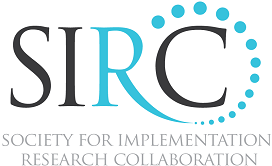Breakout I – October 14, 2011 (MC: Cara Lewis)
1. A Systematic Review of Implementation Strategies in Mental Health Service Settings
Presentation Slides Video of Presentation
Byron J. Powell, Enola K. Proctor, and Joseph E. Glass, George Warren Brown School of Social Work, Washington University in St. Louis; Center for Mental Health Services Research
The NIH has prioritized efforts to identify, refine, and test implementation strategies. The purpose of this systematic review is to demonstrate what we have learned from rigorous studies of strategies to integrate evidence-based psychosocial treatments into routine mental healthcare. Studies (N = 13) were identified through a database search of CINAHL, Medline, PsycINFO, and SocINDEX. Several methodological problems were identified, such as poor theoretical justification for use of strategies, inadequate description of strategies, absence of data on dosage and attrition, and lack of reliable and valid outcome measures. The majority of studies (92%) evaluated multifaceted implementation strategies. Individual-level targets such as provider knowledge were the most frequently addressed, whereas the process of implementation, the characteristics of the intervention, the organizational context, and the policy context were infrequently targeted. Implementation costs were assessed in only one study. Sixty-two percent of studies reported statistically significant results on at least one implementation or clinical outcome. Multifaceted, multilevel implementation strategies proved to be more effective than strategies that addressed only one or two levels of the implementation context. This review informs the conceptualization, conduct, and reporting of implementation research by discussing several areas for improvement and by presenting exemplars from the field.
2. The Soft Underbelly of System Change: The Role of Leadership and Organizational Climate in Turnover during Statewide Behavioral Health Reform
Presentation Slides Video of Presentation
Gregory A. Aarons, David H. Sommerfeld, University of California, San Diego, and Cathleen E. Willging, Behavioral Health Research Center of the Southwest
Improving the quality of mental health care requires continued efforts to move evidence-based treatments of proven efficacy into real-world practice settings with wide variability in patient characteristics and clinician skill. We present the results of a study to examine whether a flexible treatment delivery intervention would be better than usual care (UC) in reducing symptoms of anxiety and in improving functioning, health-related quality of life, and quality of care delivered for the 4 most common anxiety disorders seen in primary care—panic disorder, generalized anxiety disorder, social anxiety disorder, and posttraumatic stress disorder (PTSD). The intervention, Coordinated Anxiety Learning and Management (CALM), allowed choice of cognitive behavioral therapy (CBT), medication, or both; included real-time Web-based outcomes monitoring to optimize treatment decisions; and a computer-assisted program to optimize delivery of CBT by non-expert care managers who also assisted primary care clinicians in promoting adherence and optimizing medications. In this way, CALM sought to accommodate the complexity of real-world clinical settings, while maximizing fidelity to the evidence-base in the context of abroad range of patients, clinicians, practice settings, and payers. The randomized controlled effectiveness trial of CALM compared with usual care took place in 17 primary care clinics in 4 U.S. cities. At 12 months, response and remission rates (CALM vs. UC) were 63.66 percent vs. 44.68 percent, and 51.49 percent vs. 33.28 percent, with a number needed to treat of 5.27 for response and 5.50 for remission. Significant changes also occurred for functional status and quality of life, and were evident for each of the individual anxiety disorders. The flexibility of treatment (e.g., variation in number and type of sessions, and in criteria for continuing further treatment, use of both telephone and in-person contact), the targeting of multiple disorders, and the clinical effectiveness across a range of patients and clinics suggest that the CALM treatment delivery model should be broadly applicable in primary care. Furthermore,, the success of the model tested here demonstrates that addressing multiple common mental disorders in the context of one delivery model is feasible and effective and could serve as a template for the development of unified approaches to management of the multiple psychiatric comorbidities that are the rule rather than the exception in both the general population and in clinical practice.
3. The Importance of an Effective Implementation Team – Learning from Failure
Presentation Slides Video of Presentation
Helen Best, and Shari Manning, Treatment Implementation Collaborative, LLC
After being involved in 32 large scale implementation projects, that have, for the most part, failed to produce comprehensive DBT programs without significant drift and lack of sustainability, it is apparent long term sustainability and community mental health are incongruent when laid against the backdrop of politics (both internal and external), staff transience and funding. The only factor that can counteract the incongruence is a clearly delineated, high functioning team to support the EBP that is being implemented. This team should have:
- content expertise
- influence to impact above and below
- authority to make necessary changes (policy, staffing, integration into the existing culture, programming schedules and when needed, external providers)
The team should work in tandem with expert trainers and consultants in the EBP to formulate the scope, timeline and detailed rollout which includes everything from informational overview through adherence/certification of practitioners. In this presentation, the roles of members of the EBP implementation team will be discussed along with case studies of success and failure.
